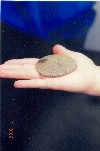Key to Class Echinoidea (Urchins and Sand Dollars)
Phylum EchinodermataTaken primarily from Kozloff,
1987, 1996 (Copyright
1987, 1996, University of
Washington Press. Used in this web page by permission of
University
of Washington Press)
| Jump to: | ||||
| Lower taxonomic level | Main Page | Alphabetic Index | Systematic Index | Glossary |
| 1a | A sand dollar--body disk-shaped, its
diameter several times greater
than the thickness
 |
Dendraster excentricus |
| 1b | Body not disk-shaped, its diameter not more than twice the thickness | 2 |
| 2a | A heart urchin--the body nearly heart-shaped when viewed from the oral or aboral side; ambulacra in distinct furrows, one of which is much deeper than the others; symmetry essentially bilateral, the mouth at one end of the oral surface (close to the deepest ambulacral furrow) and the anus at the margin of the test on the opposite side | Brisaster latifrons |
| 2b | Sea urchins--body tomato-shaped, circular in outline when viewed from the oral or aboral side; ambulacra not in distinct furrows; symmetry almost perfectly radial, the mouth at the center of the oral surface and the anus at the center of the aboral surface | 3 |
| 3a | Prevailing general color greenish or whitish, definitely not red, purple, or orange-pink | 4 |
| 3b | Prevailing color red, purple, or orange-pink | 5 |
| 4a | Prevailing color of spines whitish, although some, especially near the center of the aboral surface, may be greenish or reddish; ridges on the spines with nearly flat surfaces and without obvious sculpturing; tube feet usually either lighter than the spines or about the same color, rarely much darker; diameter of test not often greater than 6 cm (but sometimes nearly 8 cm); cleaned test mostly white, but with light green to reddish tints in the region of the periproct; primary spines with 17-26 lengthwise wedges; usually with 6 or 7 pore pairs in each arc; oral spines white, with reddish brown or brown tips, the color persisting for several days after specimens have been preserved in formalin; strictly subtidal and usually at depths greater than 30 m | Strongylocentrotus pallidus |
| 4b | Prevailing color of spines pale green; ridges on
spines with rounded
surfaces and with periodic sculpturings (these somewhat fan-shaped); tube
feet darker than the spines, and usually purple; diameter of test
frequently more than 6 cm (maximum about 8 cm); cleaned test
decidedly greenish; primary spines with 26-36 lengthwise wedges; with 5
or 6 pore pairs in each arc; oral spines slightly purplish, sometimes
with
white tips, becoming distinctly purple after specimens have been
preserved
in formalin; intertidal and subtidal
|
Strongylocentrotus droebachiensis |
| 5a | Prevailing color of living animal orange-pink; cleaned test pale orange-pink, extremely fragile; subtidal and mostly at depths greater than 100 m | Allocentrotus fragilis |
| 5b | Prevailing color of living animal red or purple; cleaned test usually gray or pale purple not extremely fragile; intertidal and subtidal | 6 |
| 6a | Prevailing color usually bright red, reddish purple, or maroon, although the larger spines of lighter individuals may be rose and the smaller spines may be almost white; diameter of test up to about 15 cm; spines up to 7 cm long; intertidal and subtidal (Strongylocentrotus franciscanus in original key) | Mesocentrotus franciscanus |
| 6b | Prevailing coloration purple; diameter of test
not exceeding 9 cm; spines rarely more than 2.5 cm long; largely
intertidal
on rocky shores that have considerable wave action, but subtidal to
some
extent
|
Strongylocentrotus purpuratus |
Taxonomic Levels Represented in This Key:
Dendraster excentricus
Mesocentrotus
franciscanus
Strongylocentrotus
droebachiensis
Strongylocentrotus
pallidus
Strongylocentrotus
purpuratus
Page created by Heidee Leno, 7-26-2002
Edited by: Dave Cowles 8-2002, 2005, 2006-